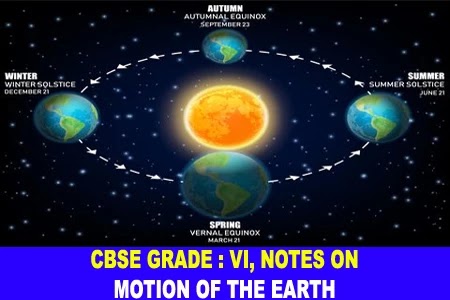Grade : VI
Geography CHAPTER : 4
Motion Of The Earth
Question And Answers
31st October 2022
Date : 31st October, Day : Monday
Que : How does day and night occur?
Answer :
- The main reason for the occurrence of day and night is the rotation of the earth.
- Only half of the earth faces the sun and the other half remains away from the sun.
- It is daytime on the part of the earth that faces the sun, while it is night in the other half.
- The circle that divides day and night on the globe is called the circle of illumination.
Que : Compare Summer Solstice and Winter Solstices?
Answer :
| SUMMER SOLSTICE | WINTER SOLSTICE |
|---|---|
| The summer solstice happens on 21 June in the Northern Hemisphere. | The winter solstice occurs on 22 December in the Northern Hemisphere. |
| The areas near the Tropic of Cancer receive maximum sunlight due to the tilt of the North Pole towards the sun | The areas near the Tropic of Capricorn receive maximum sunlight due to the tilt of the South Pole towards the sun |
| It experience longer days and shorter nights in the Northern Hemisphere | It experience shorter days and longer nights in the Northern Hemisphere |
| The areas beyond the Arctic Circle remain in daylight for six months at a stretch | The areas beyond the Arctic Circle remain in darkness for six months during winter |
Que : Explain how a leap year happens?
Answer :
- There are 365 days in a calendar year.
- Though the earth takes 365 days and six hours to complete one revolution around the sun,
- But for the sake of convenience, we ignore the quarter day, which is six
- hours, and think of a year having 365 days.
- Over four years, the remaining six hours add up to 24 hours, or one full day.
- This day is added to the calendar every four years in the month of February as
- the 29th day.
- This is why, every fourth year is a leap year.
1st November 2022
Date : 1st November, Day : Wednesday
Que : Compare Solstice and Equinoxes?
Answer :
| SOLSTICE | EQUINOXES |
|---|---|
| The word ‘solstice’ comes from the Latin words sol, meaning ‘sun’, and stitium, meaning ‘to stand still’. | The word equinox is derived from the Latin word aequinoctium, which means ‘equal night’. |
| The solstices occur twice a year, on 21st June and 22nd December. | Equinoxes occur twice a year, on 21 March and 23 September. |
| It occur when the sun is farthest from the equator. | It occur when the sun is nearest to the equatorial region |
| Sun shine directly over the tropic | Sun shine directly over the equator |
| The length of days and nights are unequal during solstices. | The length of days and nights are equal during equinox. |
| The two types of solstices are summer solstice (21st June) and winter solstice (22nd December). | The two types of equinoxes are spring equinox (21 March ) and
autumn equinox ( 23 September ) |

